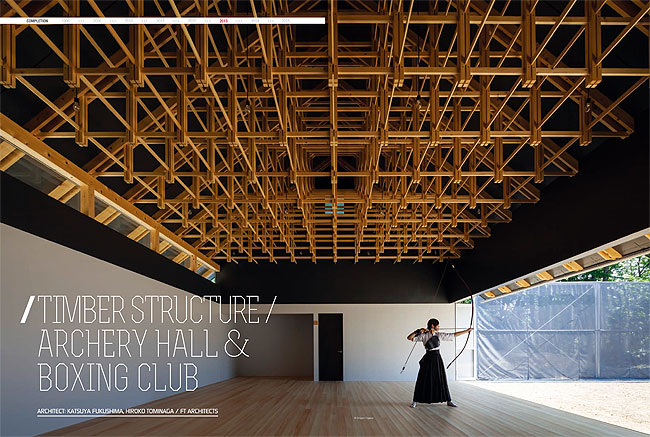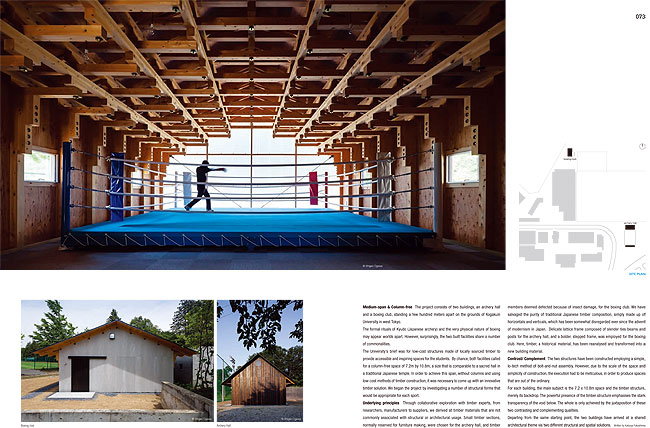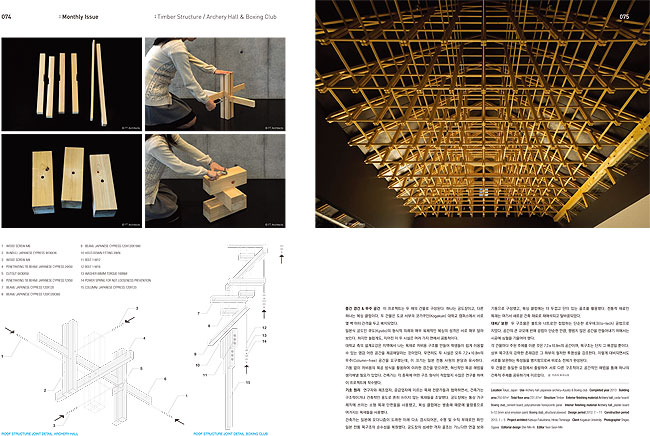timber structure archery hall boxing club
Architect : Katsuya Fukushima, Hiroko Tominaga / FT Architects



중간 경간 & 무주 공간 이 프로젝트는 두 채의 건물로 구성된다. 하나는 궁도장이고, 다른 하나는 복싱 클럽이다. 두 건물은 도쿄 서부의 코가쿠인(Kogakuin) 대학교 캠퍼스에서 서로 몇 백 미터 간격을 두고 배치되었다.
일본식 궁도인 큐도(Kyudo)의 형식적 의례와 매우 육체적인 복싱의 성격은 서로 매우 달라 보인다. 하지만 놀랍게도, 지어진 이 두 시설은 여러 가지 면에서 공통적이다. 대학교 측의 설계요강은 지역에서 나는 목재로 저비용 구조를 만들어 학생들이 쉽게 이용할 수 있는 영감 어린 공간을 제공해달라는 것이었다. 우연히도 두 시설은 모두 7.2ⅹ10.8m의 무주(Column-free) 공간을 요구했는데, 이 크기는 일본 전통 사원의 본당과 유사하다. 기둥 없이 저비용의 목공 방식을 활용하여 이러한 경간을 얻으려면, 혁신적인 목공 해법을 생각해낼 필요가 있었다. 건축가는 각 종목에 어떤 구조 형식이 적합할지 수많은 연구를 하며 이 프로젝트에 착수했다.
기초 원리 연구자와 제조업자, 공급업자에 이르는 목재 전문가들과 협력하면서, 건축가는 구조적이거나 건축적인 용도로 흔히 쓰이지 않는 목재들을 조달했다. 궁도장에는 통상 가구 제작에 쓰이는 소형 목재 단편들을 사용했고, 복싱 클럽에는 병충해 때문에 불량품으로 여겨지는 목재들을 사용했다.
건축가는 일본에 모더니즘이 도래한 이래 다소 경시되어온, 수평 및 수직 부재로만 짜인 일본 전통 목구조의 순수성을 복원했다. 궁도장의 섬세한 격자 골조는 가느다란 연결 보와 기둥으로 구성했고, 복싱 클럽에는 더 두껍고 단이 있는 골조를 활용했다. 전통적 재료인 목재는 여기서 새로운 건축 재료로 재해석되고 탈바꿈되었다.
대비/ 보완 두 구조물은 볼트와 너트로만 접합하는 단순한 로우테크(lo-tech) 공법으로 지었다. 공간의 큰 규모에 반해 공법이 단순한 만큼, 평범치 않은 공간을 만들어내기 위해서는 시공에 심혈을 기울여야 했다.
각 건물마다 주된 주제를 이룬 것은 7.2ⅹ10.8m의 공간이며, 목구조는 단지 그 배경일 뿐이다. 상부 목구조의 강력한 존재감은 그 하부의 철저한 투명성을 강조한다. 이렇게 대비되면서도 서로를 보완하는 특성들을 병치함으로써 비로소 전체가 완성된다. 두 건물은 동일한 요점에서 출발하여 서로 다른 구조적이고 공간적인 해법을 통해 하나의 건축적 주제를 공유하기에 이르렀다.
글: 카츠야 후쿠시마
Medium-span & Column-free The project consists of two buildings, an archery hall and a boxing club, standing a few hundred meters apart on the grounds of Kogakuin University in west Tokyo.
The formal rituals of Kyudo (Japanese archery) and the very physical nature of boxing may appear worlds apart. However, surprisingly, the two built facilities share a number of commonalities.
The University’s brief was for low-cost structures made of locally sourced timber to provide accessible and inspiring spaces for the students. By chance, both facilities called for a column-free space of 7.2m by 10.8m, a size that is comparable to a sacred hall in a traditional Japanese temple. In order to achieve this span, without columns and using low-cost methods of timber construction, it was necessary to come up with an innovative timber solution. We began the project by investigating a number of structural forms that would be appropriate for each sport.
Underlying principles Through collaborative exploration with timber experts, from researchers, manufacturers to suppliers, we derived at timber materials that are not commonly associated with structural or architectural usage. Small timber sections, normally reserved for furniture making, were chosen for the archery hall, and timber members deemed defected because of insect damage, for the boxing club. We have salvaged the purity of traditional Japanese timber composition, simply made up of horizontals and verticals, which has been somewhat disregarded ever since the advent of modernism in Japan. Delicate lattice frame composed of slender ties beams and posts for the archery hall, and a bolder, stepped frame, was employed for the boxing club. Here, timber, a historical material, has been reanalysed and transformed into a new building material.
Contrast/ Complement The two structures have been constructed employing a simple, lo-tech method of bolt-and-nut assembly. However, due to the scale of the space and simplicity of construction, the execution had to be meticulous, in order to produce spaces that are out of the ordinary.
For each building, the main subject is the 7.2 x 10.8m space and the timber structure, merely its backdrop. The powerful presence of the timber structure emphasises the stark transparency of the void below. The whole is only achieved by the juxtaposition of these two contrasting and complementing qualities.
Departing from the same starting point, the two buildings have arrived at a shared architectural theme via two different structural and spatial solutions.
Written by Katsuya Fukushima
Timber A timber vendor was part of our team from the design phase, so we were able to feedback the tectonics of the lumbermill and the information of the timber vendor to the design. It was possible to lumber the timber into the profile as necessary and choose the cheapest and high performance timber that is in “season”. We chose a small dimension wood (Japanese cypress) usually used as a substrate member for the archery hall, and pest damaged column member (pest damaged Japanese cypress) for the boxing club. Pest damaged timber that only have small holes and have no problem in strength compared to the usual timber are called “Akane member” in Japan. Harmful rumors damage the reputation of them and stagnates the distribution. Through actively using them in design, we were dealing with this problem. Experiment We conducted structural testing on the member joints at Naohito Kawai Laboratory in Kogakuin University. The joints were evaluated that it is neither a pin joint or a rigid joint but a spring like half rigid joint. We reinterpreted the softness and tenacious of wood and positively thought about the sinking and friction. The member dimension becomes minimum for the frame of the archery hall and the variety of member becomes minimum for the frame of the boxing club.
목재 설계단계에서부터 한 제재목 판매업체가 팀에 합류했기 때문에, 설계팀은 제재소의 기술과 제재목 판매업체의 정보를 설계에 반영할 수 있었다. 마침 계절상 ‘제철’이었던 터라 가장 싸고 성능 좋은 제재목을 선택하여 원하는 형태로 가공할 수 있었다. 궁도장에는 작은 치수로 잘라낸 편백나무를 기본 부재로 주로 사용했고, 복싱 클럽에는 병충해를 입은 편백나무를 기둥 부재로 사용했다. 병충해를 입긴 했지만 작은 구멍이 났을 뿐이어서, 일본에서 소위‘ 아카네(Akane) 부재’라 불리는 일반 제재목에 비해 강도상 문제는 없다. 이런 목재가 해롭다는 소문이 안 좋은 평판을 만들어 유통이 잘 안되고 있을 뿐이다. 우리는 이런 목재를 설계에 적극적으로 활용함으로써 이 문제에 대처했다. 실험 우리는 코가쿠인 대학교의 나오히토 카와이 연구소에서 이러한 부재들의 접합 구조를 검사했다. 접합점들은 강절도 활절도 아닌 준-강절의 탄성 접합으로 평가되었다. 우리는 목재의 연성과 경성을 재해석했고, 패인 구멍과 마찰에 대해 서는 긍정적으로 생각했다. 궁도장의 골조 부재는 치수를 최소화했고, 복싱 클럽의 골조 부재는 다양성을 최소화했다.
About ‘wood structure’ Interview with Katsuya Fukushima
What types of wood have you used in this project, and what general properties do they have? The wood we used for this project was cypress. Cypress is a special kind of wood that only grows in Japan and Taiwan. It is a valuable in Japan because it is structurally strong, easy to handle and its fine grain. How have you resolved such disadvantages of wood as shrinkage, distortion, structural weakness, and the vulnerability to fire? The shrinkage was minimized by artificially drying the lumber carefully with time. The moisture content is less than 15%. The distortion barley occurs because after artificially drying, the surface was mechanically planed. The structural weakness was resolved for the archery hall by the number of members even of its slenderness and gains redundancy. For the boxing club, the quantity of members achieves the redundancy, because we could reduce the cost of timber though using pest-damaged wood. What do you think as an architect are the advantages and values of wood as a building material? Wood is a material that could be reproduced by appropriate forestry, so it is suitable for our contemporary sustainable society. I think the advantages of wood are, it is soft and easy to process, it is week but light so the weight of the structure could be kept low and it could be produced with little energy. How do you expect the use of wood will develop in future? What kind of design do you want to materialize with wood? The structural weakness was one of the big disadvantages of wood. However, through design and contemporary computer technology, we could make up for it. Wood is a material that we can think about its new usages. I do not have a specific image on what kind of design I would like to do with wood. What is characteristic of Japanese wooden architecture? What species of trees are mainly used? Why do you think wooden architecture has retained life in Japan? The characteristic of traditional Japanese wooden architecture are said to be that it looks like the simple wooden structural frame became the space itself. This is because the finishing is designed as if it is the structure, even though the structure and the finishing was separated hundreds of years ago and the finishing has become free from it. I think this two-sidedness of structure and finishing is the biggest characteristic of Japanese wooden architecture. In Japan this is called Wa-Yo (Japanese style). Cypress, pine and cedar are the mainly used tree species in Japan.
Wood has retained life in Japan because simply, it is an abundant material. Japan is said that it is one of the most suitable areas for growing trees. In order to grow trees, it needs to be an environment where it has both many sunny days and rainy day, and Japan miraculously is that kind of environment.
About what should we be careful when designing and undertaking construction with wood?
Since wood is an old material, it is important that we learn from history of its usage. On the other hand, it is a contemporary material where the latest technologies are developed, including biotechnology. Thus it is also important to gain those latest information. I think it is important for us to be conscious of this two-sidedness of wood. Wood is a very old and new architectural material.
사용된 목재의 종류와 그 특성에 대해 설명해달라. 이 프로젝트에 사용한 목재는 편백나무다. 편백나무는 일본과 대만에서만 자라는 특수한 수종이자, 일본에서는 귀한 수종 이다. 왜냐하면 구조적으로 강하고, 다루기 쉬우며, 결이 곱기 때문이다. 목재의 단점으로 여겨지는 수축, 뒤틀림, 구조적 취약점, 화재 등의 보완은 어떻게 해결하였는가?
시간을 두고 목재를 세심하게 인공 건조시킴으로써 수축을 최소화했다. 수분 함량은 15% 미만이다. 인공 건조한 후에 기계로 표면을 평탄하게 만들었기 때문에, 뒤틀림도 거의 발생하지 않는다.
궁도장의 경우 가늘지만 많은 목재를 사용하여 구조적 부정정 상태를 만드는 방식으로 구조적 취약점을 해결했다. 복싱 클럽의 경우에도 병충해를 입은 목재를 사용하여 비용을 줄인 만큼 많은 양의 부재를 활용하여 부정정 상태를 성취할 수 있었다.
건축가가 생각하는 목재의 재료적인 매력과 그 가치는 무엇인가?
목재는 적절한 산림관리로써 재생산할 수 있는 재료이기 때문에, 현대인이 추구하는 지속 가능한 사회에 적합한 재료다. 목재는 부드럽고 다루기 쉬운 게 매력인 거 같다. 목재는 약하지만 가벼워서 구조물의 무게를 줄일 수 있고, 적은 에너지로 구조물 생산이 가능하다.
앞으로 목재의 쓰임이 어떻게 발전할 것으로 예상하는가? 목재를 통해 구현해보고 싶은 디자인은 무엇인가?
구조적 취약성은 목재의 커다란 단점 중의 하나였다. 하지만 디자인과 현대 컴퓨터 기술을 통해 그러한 단점을 보완할 수 있다. 목재는 새로운 용도를 고민해볼 수 있는 재료다. 목재로 어떤 종류의 디자인을 하고 싶은지에 대해서는 구체적인 이미지를 그리고 있지 않다.
일본의 목조건축의 특성과 주로 쓰이는 수종(樹種)은 무엇 이며, 일본에서 목조건축이 꾸준히 계승되어 온 이유는 무엇 이라고 생각하는가?
일본 전통 목조건축의 특성은 마치 단순한 목조 프레임이 공간 자체가 된 것처럼 보이는 데에 있다고들 한다. 그렇게 보이는 이유는, 이미 수백 년 전에 마감이 구조로부터 분리 되어 독립성을 얻었음에도 마감이 마치 구조인 것처럼 설계 되기 때문이다. 나는 구조와 마감의 이러한 양면성이 일본 목조건축의 가장 큰 특성이라고 생각한다. 일본에서는 이를 와요(和 , 일본 양식)라고 부른다.
편백나무와 소나무, 그리고 삼나무가 일본에서 주로 쓰이는 수종이다. 일본에서는 목재가 풍부하기 때문에 생명력을 유지했다.
일본은 나무를 기르기에 가장 적합한 곳 중의 하나라고 한다. 나무를 기르려면 햇볕이 드는 날도, 비가 오는 날도 많아야 하는 환경적 조건이 필요한데, 일본은 바로 그러한 천혜의 환경을 갖추고 있다.
목재를 다루는 건축물의 설계, 시공 과정의 주안점은 무엇 이라고 생각하는가?
목재는 오래된 재료이기 때문에, 과거에 목재가 어떻게 사용 되었는지의 역사를 알아보고 교훈을 얻는 게 중요하다. 반대로 목재는 생명공학기술과 같은 최신 기술의 발달과 결합하는 현대적인 재료이기도 하다. 따라서 그런 최신 정보를 획득하는 것 또한 중요하다. 목재의 이러한 양면 성을 의식하는 게 중요하다고 생각한다. 목재는 아주 오래 되었으면서도 새로운 건축 재료다.
건축문화 2016년 2월호 [Monthly Issue]페이지 © 에이엔씨출판(주)